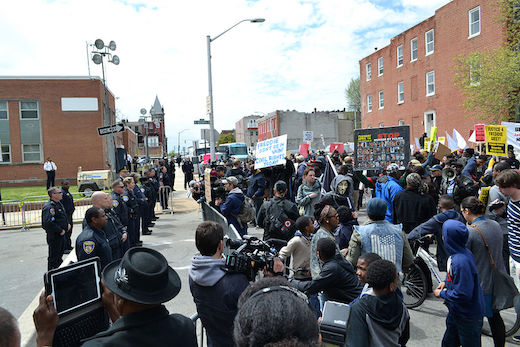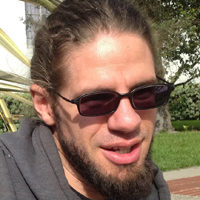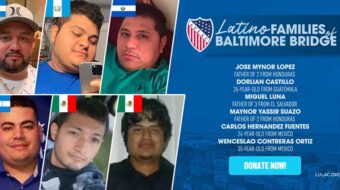
While in police custody, Freddie Gray’s spine was “80 percent severed at the neck.” The 25-year-old also suffered three fractured vertebrae and a partially damaged larynx — family members say his voice box was almost crushed. After slipping into a coma, he died a week after Baltimore police arrested him.
It’s still not clear that Gray even committed a crime, but it is clear that police violated many of his constitutional rights.
The violation of Gray’s rights is not an isolated incident and only adds to a long list of U.S. law enforcement abusing its power over people of color. All this needs to be understood as part of the reason why people fought back against authorities in Baltimore, using both peaceful and more violent forms of protest.
While it’s important to discuss the issues of criminality and property rights around the uprisings in Baltimore, we must not forget the initial cause of these events: the violation of Freddie Gray’s constitutional rights.
Before we speak on Baltimore burning, everyone who stands for the same rights protected under the U.S. Constitution should also be speaking out against police brutality committed against African Americans, Latinos, people of color and low-income people in this country.
“Get off my neck” … “I can’t breath”
On Sunday morning, Apr. 12, Freddie Gray noticed a Baltimore police lieutenant and ran down the street in the opposite direction. Even though no crime had been committed, the police say that running gave them reasonable suspicion of wrongdoing, so they pursued Gray and questioned him a couple blocks later. Officers say that Gray gave himself up voluntarily.
After the police stopped Gray, official charging documents say they “noticed a knife clipped to the inside of his front right pants pocket.” Supposedly, this gave police probable cause to conduct a search. However, if the knife was clipped inside his front pocket, how was it visible to officers? This part of the story is not clear.
Gray’s family lawyer claims Gray had a “pocket knife of legal size,” but the law seems somewhat fuzzy on exactly what is legal to carry in Maryland and within Baltimore city limits. Others say the arrest was based on an antiquated law that makes the actual charge of wrongdoing questionable.
While all the facts are still not known, according to one witness, when officers detained Gray, they put his “body up into… a pretzel type of move where they had the heels of his feet to his back.” The same witness said that Gray “was still in handcuffs and then they (police) had their knee in the back of his neck.”
Another man in the community said he heard Gray repeatedly yell: “Get off my neck. You’re hurting my neck.” Hearing the screams, a third witness ran to the scene and asked Gray if he was OK. His response: “I can’t breath.”
These words ring eerily similar to Eric Garner, whose life ended with an NYPD chokehold. In Oklahoma, the phrase “I’m losing my breath” came from the mouth of Eric Harris after a volunteer deputy shot him in the back. A Tulsa officer replied “F*** your breath,” as Harris lay dying.
“Why did Mr. Gray need medical attention in the first place?”
Although the official police report says that Gray “was arrested without force or incident,” cellphone video reveals that police did forcibly have Gray’s legs twisted and bent behind him. At least two videos show that Gray could not walk on his own when police picked him off the ground.
As officers dragged Gray to a police transport van, he screamed in pain and asked for medical assistance, including his inhaler. Despite repeated requests, authorities did not call medics until almost 45 minutes later. This was after the van made at least two more stops, including one where police placed shackles on Gray’s legs in addition to his handcuffs.
By the time Gray arrived at the police station, he was unresponsive. He could not speak, nor could he breath properly. This is when police finally called medics.
Officials have admitted that Gray was not properly buckled in while sitting in the back of the police van. Reports have also come out saying that he was “thrashing about” during the transport. Did police injure Gray while being taken into custody or did he “injure himself” in the van? How could that injury have occurred?
There is the possibility that part of his police escort to the station might have included a “nickel ride” — where officers are known to purposely bounce shackled suspects in the back of their vehicles while driving erratically at high speeds.
Is it odd that officers would stop the van in order to restrain Gray with leg shackles yet leave his safety belt unbuckled?
Baltimore police deny Gray had a “rough ride” but have admitted that Gray should have been buckled in and that he should have received adequate medical attention in a timely manner. His family’s lawyer says this “does not get at the core of this case and that is why did Mr. Gray need medical attention in the first place?”
Where does justice lie?
It’s easy for some people to blow off Freddie Gray’s experience with police because they know they would receive better treatment. What many don’t understand is that U.S. law enforcement continually forces people of color to forfeit their rights in this manner and then dole out physical punishment if those people don’t comply.
This is why if you believe in equality under the U.S. Constitution, you should believe in justice for Freddie Gray.
Considering Eric Garner in New York, Mike Brown in Ferguson, Rekia Boyd in Chicago, and many others who have died at the hands of police without legal retribution, it is not surprising that many people felt there would be little justice for Freddie Gray. Proactively, many have protested peacefully to demand accountability for Gray’s death.
So far, the Baltimore Police Department has responded that Gray died from lacking a seatbelt, delayed medical attention, and/or his own actions, but not from use of force. Many people seeking justice understand that, at best, information is somewhere being withheld, and at worst, lies are being told that ignore eyewitness reports, video evidence, and what we all know: people seeking medical attention don’t try to break their own necks.
Even though all 6 police officers involved in Gray’s arrest have now been charged, many are still concerned that a court of law may not hold them fully accountable. This is why protestors are calling into question police protocol and the overall justice system. This is also part of the reason why some people have turned to violence to vent their frustrations.
“The destruction of property” vs. “The destruction of black bodies”
It’s understandable that peaceful protestors in Baltimore were upset when some chose to violate property rights by smashing windows or igniting fires, because their movement gained negative attention. Still, not all of the people chastising the youth have been as vocal about ending police brutality. This is where the movement’s energy should be focused.
“You can’t tell people how to protest,” said the HuffPost Show Co-host and CNN commentator Marc Lamont Hill in response to the violence erupting in Baltimore’s streets. When others criticized the urban unrest in Baltimore and blamed misdirected youth, criminal opportunists and thugs, Hill put things into perspective: “We have to watch our own ethics and be careful not to get more upset about the destruction of property than the destruction of black bodies.”
Hill’s critical insight is right on.
We need to first remember that police enacted violence against Gray after they initially stopped him without solid probable cause. The police not only searched his body, but they also seized and destroyed it — a violation of the 4th Amendment of the U.S. Constitution.
It can also be argued that police disregarded Gray’s 5th and 14th Amendment rights, that no person or citizen “shall be… deprived of life, liberty, or property, without due process of law.” Officers seem to have neglected other 5th and 6th Amendment rights of the accused as well.
And evidence shows that law enforcement violated Gray’s 8th Amendment right against “cruel and unusual punishments” — something it does daily across the country.
“All men are created equal… except negroes”
The conversations taking place around Freddie Gray’s homicide and other cases of police brutality too often leave out discussing citizenship and constitutional rights.
The deaths of Gray and many others show that systematic police brutality is real and that the violation of these rights supports second-class citizenship for African Americans and other oppressed people in the United States today.
“As a nation, we began by declaring that ‘all men are created equal.’ We now practically read it ‘all men are created equal, except negroes.'”
Abraham Lincoln wrote this in 1855, when fifteen states legally supported slavery. Unfortunately these words still apply 160 years later (even with Obama as president).
When law enforcement commits extralegal killings in our streets on a weekly basis, what does it say about the idea of freedom promoted by the United States today? Maybe that it’s just an idea.
Photo: Protest at the Baltimore Police Department Western District building at N. Mount St. and Riggs Ave. (Veggies/CC)

MOST POPULAR TODAY


Zionist organizations leading campaign to stop ceasefire resolutions in D.C. area

High Court essentially bans demonstrations, freedom of assembly in Deep South

Afghanistan’s socialist years: The promising future killed off by U.S. imperialism

Communist Karol Cariola elected president of Chile’s legislature






Comments